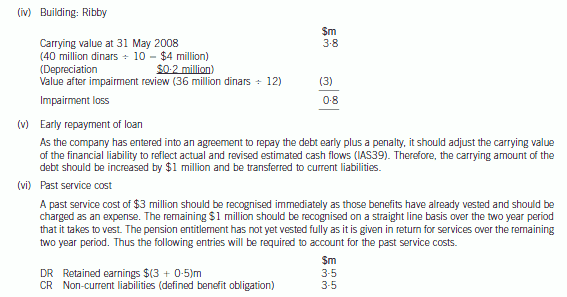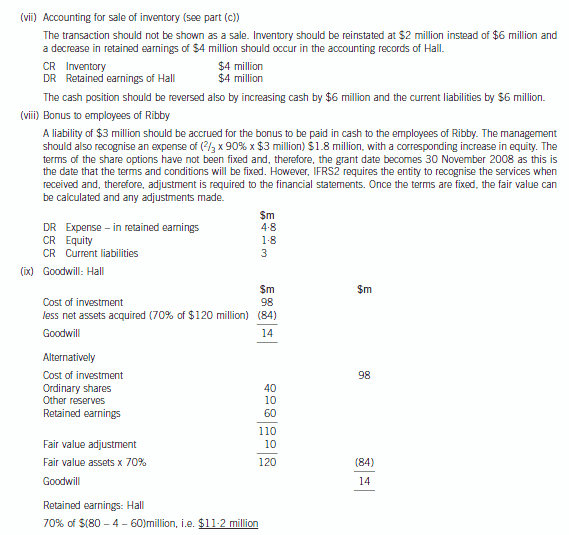中国大陆成为国际金融理财标准委员会(Financial Planning Standards Board,FPSB)正式会员的时间是( )。A.2004-9-1B.2005-4-1C.2005-7-1D.2006-4-1
题目
中国大陆成为国际金融理财标准委员会(Financial Planning Standards Board,FPSB)正式会员的时间是( )。
A.2004-9-1
B.2005-4-1
C.2005-7-1
D.2006-4-1
相似考题
更多“中国大陆成为国际金融理财标准委员会(Financial Planning Standards Board,FPSB)正式会员的时间 ”相关问题
-
第1题:
(b) Prepare a consolidated statement of financial position of the Ribby Group at 31 May 2008 in accordance
with International Financial Reporting Standards. (35 marks)
正确答案:







-
第2题:
下列关于CFP制度的建立和发展,描述错误的是( )。
A.1970年,首家金融理财的专业协会——国际金融理财协会(International Association for Financial Planning IAFP)正式成立
B.1972年美国金融理财学院创立和第一批(共计42人)学员获得国际金融理财师证书
C.1990年12月,美国CFP理事会签署了第一个CFP商标国际许可证和联属协议,协议允许日本金融理财协会参照美国CFP标准委员会的模式,向达到教育、考试、工作经验和职业道德等严格要求的日本理财师颁发CFP资格证书
D.1985年,经过美国国家资格认证管理委员会(National Commission for Certifying Agencies NCCA)的授权,美国金融理财学院和CFP学会共同设立了国际CFP标准与实践委员会(IBCFP)
参考答案:C
解析:1990年12月,美国CFP理事会签署了第一个CFP商标国际许可证和联属协议,协议允许澳大利亚金融理财协会参照美国CFP标准委员会的模式。 -
第3题:
的正式成立标志着金融理财业的正式出现。
A.注册金融理财师标准委员会
B.国际金融理财协会
C.国际金融理财人员协会
D.金融理财师协会
参考答案:C
解析:1970年,一个名为“国际金融理财人员协会”的组织诞生了,这个团体的诞生标志着金融理财业的正式出现。 -
第4题:
张先生是一名刚获得CFP资格认证的持证人。他为客户李小姐介绍金融理财和CFP资格认证制度时提到:(1)金融理财主要是比较和选择购买理财产品;(2)金融理财的目的之一是追求一生财务资源收支平衡;(3)中国在2005年7月正式成为国际金融理财标准委员会(FPSB)的会员;(4)CFP资格认证制度有严格的职业道德要求、完善的认证体系、标准的操作程序和完善的继续教育要求。张先生的说法中,正确的是( )。
A.(1) (3)
B.(1) (4)
C.(2) (3)
D.(2) (4)
参考答案:D
解析:金融理财是专业人员为客户进行一生综合理财规划提供理财服务,所以(1)不正确;中国在2005年7月成为FPSB准会员,2006年4月成为FPSB正式会员,所以(3)不正确。 -
第5题:
下列有关CFP资格认证制度在我国建立和发展的说法,正确的是( )。 (1)CFP资格认证采用两级认证是我国选择CFP资格认证制度的首要原因 (2)具有标准的操作程序和完整的继续教育要求是我国选择CFP资格认证制度的原因之一 (3)2004年9月,中国金融理财标准委员会成立 (4)2006年4月,中国金融理财标准委员会成为FPSB正式会员
A.(1)(2)(3)
B.(1)(4)
C.(2)(3)(4)
D.(1)(2)(3)(4)
参考答案:C
解析:我国选择CFP资格认证制度的原因有严格的职业道德要求,完善的认证体系,标准的操作程序,合理的知识结构和系统的教材体系,强调本土化以及有完整的继续教育要求。 -
第6题:
下列关于CFP资格认证制度的发展历史的说法中,错误的是( )。
A.CFP资格认证制度最早可追溯到20世纪30年代保险营销人员开始提供金融理财服务
B.1973年,国际金融理财师协会(ICFP)成立并开始使用“CFP”商标
C.2004年,国际金融理财标准委员会(FPSB)正式成立,统一管理全球(除美国之外)的CFP商标
D.2005年7月,FPSB正式批准FPSCC为准会员
参考答案:A
解析:金融理财的发展最早可以追溯到20世纪30年代保险营销人员开始提供金融理财服务。1973年,国际金融理财师协会成立并开始使用“CFP”商标,标志着CFP资格认证制度开始发展。 -
第7题:
国际金融理财师(CFP)认证申请人在取得AFP认证后,需要参加中国金融理财标准委员会组织的( )学时的CFP培训,并报名参加标准委员会组织的国际金融理财师CFP全国统一考试
A.132
B.108
C.128
D.136
参考答案:A
-
第8题:
FPSB(国际金融理财标准委员会)监督国际CFP资格认证标准的发展,保护美国境外客户的权益,并使他们从中受益。达到FPSB初次认证和再认证标准的个人被授权在其获得认证的国家或地区使用符合规定的商标,下列不符合《CFP商标使用指南》的要求的是( )。
A.

B.C.F.P.
C.CFP
D.CERTIFIED FINANCIAL PLANNER
参考答案:B
-
第9题:
年国际金融理财标准委员会(FPSB)正式成立
A.2000
B.2002
C.2005
D.2004
参考答案:D
-
第10题:
有关CFP资格认证制度的发展历史,下列说法不正确的是()。
- A、CFP制度最早可追溯到20世纪30年代保险营销人员开始提供金融理财服务
- B、1972年,国际金融理财协会(IAFP)创立专业的教育培训机构——金融理财学院(CollegeforFinancialPlanning),开始使用CFP认证标志
- C、C.2004年,国际CFP理事会(theInternationalCFPCouncil)伦敦年会上,国际金融理财标准委员会(FPS正式成立,统一管理全球除美国之外的CFP商标
- D、D.2005年8月,中国金融教育发展基金会金融理财标准委员会(FPSCC.签字加入国际金融理财标准委员会(FPS
正确答案:A -
第11题:
简述飞行标准委员会——FSB(Flight Standard Board)。
正确答案: FSB的主要工作是制定飞行机组训练和资格标准。
包括建立型号等级要求;
审查飞机飞行手册、使用手册;
检查单和训练大纲的内容、训练设施和模拟机等。 -
第12题:
单选题体育舞蹈正式成为国际林匹克委员会会员的时间是()A1997/9/4
B1998/9/4
C1996/9/4
正确答案: A解析: 暂无解析 -
第13题:
(b) Identify and explain the financial statement risks to be taken into account in planning the final audit.
(12 marks)
正确答案:
(b) Financial statement risks
Tutorial note: Note the timeframe. Financial statements for the year to 30 June 2006 are draft. Certain misstatements
may therefore exist due to year-end procedures not yet having taken place.
Revenue/(Receivables)
■ Revenue has increased by 11·8% ((161·5 – 144·4)/144·4 × 100). Overstatement could arise if rebates due to customers
have not yet been accounted for in full (as they are calculated in arrears). If rebates have still to be accounted for trade
receivables will be similarly overstated.
Materials expense
■ Materials expense has increased by 17·8% ((88.0 – 74·7)/74·7 × 100). This is more than the increase in revenue. This
could be legitimate (e.g. if fuel costs have increased significantly). However, the increase could indicate misclassification
of:
– revenue expenditure (see fall in other expenses below);
– capital expenditure (e.g. on overhauls or major refurbishment) as revenue;
– finance lease payments as operating lease.
Depreciation/amortisation
■ This has fallen by 10·5% ((8·5 – 9·5)/9·5 × 100). This could be valid (e.g. if Yates has significant assets already fully
depreciated or the asset base is lower since last year’s restructuring). However, there is a risk of understatement if, for
example:
– not all assets have been depreciated (or depreciated at the wrong rates, or only for 11 months of the year);
– cost of non-current assets is understated (e.g. due to failure to recognise capital expenditure)1;
– impairment losses have not been recognised (as compared with the prior year).
Tutorial note: Depreciation on vehicles and transport equipment represents only 7% of cost. If all items were being
depreciated on a straight-line basis over eight years this should be 12·5%. The depreciation on other equipment looks more
reasonable as it amounts to 14% which would be consistent with an average age of vehicles of seven years (i.e. in the middle
of the range 3 – 13 years).
Other expenses
■ These have fallen by 15·5% ((19·6 – 23·2)/23·2 × 100). They may have fallen (e.g. following the restructuring) or may be
understated due to:
– expenses being misclassified as materials expense;
– underestimation of accrued expenses (especially as the financial reporting period has not yet expired).
Intangibles
■ Intangible assets have increased by $1m (16% on the prior year). Although this may only just be material to the
financial statements as a whole (see (a)) this is the net movement, therefore additions could be material.
■ Internally-generated intangibles will be overstated if:
– any of the IAS 38 recognition criteria cannot be demonstrated;
– any impairment in the year has not yet been written off in accordance with IAS 36 ‘Impairment of Assets’.
Tangible assets
■ The net book value of property (at cost) has fallen by 5%, vehicles are virtually unchanged (increased by just 2·5%)
and other equipment (though the least material category) has fallen by 20·4%.
■ Vehicles and equipment may be overstated if:
– disposals have not been recorded;
– depreciation has been undercharged (e.g. not for a whole year);
– impairments have not yet been accounted for.
■ Understatement will arise if finance leases are treated as operating leases.
Receivables
■ Trade receivables have increased by just 2·2% (although sales increased by 11·8%) and may be understated due to a
cutoff error resulting in overstatement of cash receipts.
■ There is a risk of overstatement if sufficient allowances have not been made for the impairment of individually significant
balances and for the remainder assessed on a portfolio or group basis.
Restructuring provision
■ The restructuring provision that was made last year has fallen/been utilised by 10·2%. There is a risk of overstatement
if the provision is underutilised/not needed for the purpose for which it was established.
Finance lease liabilities
■ Although finance lease liabilities have increased (by $1m) there is a greater risk of understatement than overstatement
if leased assets are not recognised on the balance sheet (i.e. capitalised).
■ Disclosure risk arises if the requirements of IAS 17 ‘Leases’ (e.g. in respect of minimum lease payments) are not met.
Trade payables
■ These have increased by only 5·3% compared with the 17·8% increase in materials expense. There is a risk of
understatement as notifications (e.g. suppliers’ invoices) of liabilities outstanding at 30 June 2006 may have still to be
received (the month of June being an unexpired period).
Other (employee) liabilities
■ These may be understated as they have increased by only 7·5% although staff costs have increased by 14%. For
example, balances owing in respect of outstanding holiday entitlements at the year end may not yet be accurately
estimated.
Tutorial note: Credit will be given to other financial statements risks specific to the scenario. For example, ‘time-sensitive
delivery schedules’ might give rise to penalties or claims, that could result in understated provisions or undisclosed
contingent liabilities. Also, given that this is a new audit and the result has changed significantly (from loss to profit) might
suggest a risk of misstatement in the opening balances (and hence comparative information).
1 Tutorial note: This may be unlikely as other expenses have fallen also. -
第14题:
的正式成立标志着美国CFP考试实现正规化。
A.国际金融理财协会
B.金融理财师协会
C.国际金融理财师协会
D.注册金融理财师标准委员会
参考答案:D
解析:1985年在美国科罗拉多州的丹佛,美国注册金融理财师标准委员会(Certified Financial Planner Board of Standard,CFP Board)正式成立。金融理财师认证管理机构从金融理财学院变成一个独立的体系,开始对从业者进行正规的认证管理,这标志着CFP认证考试开始正规化。 -
第15题:
下列关于“现代国际金融理财标准(上海)有限公司”(英文简称“FPSB China”)的说法中,错误的是( )。
A.FPSB China是非政府、非营利的行业自律组织
B.FPSB China是唯一取得中国金融教育发展基金会(CFDFE)授权、在中国大陆开展CFP资格认证工作、管理和使用CFP商标的机构
C.FPSB China的前身是“中国金融教育发展基金会金融理财标准委员会”
D.FPSB China的职责是在中国建立CFP资格认证制度,确立资格标准;组织资格考试,认证专业人才;规范职业道德,维护行业秩序
参考答案:B
解析:FPSBChina是中国唯一取得国际金融理财标准委员会(FPSB)授权、在中国大陆开展CFP资格认证工作、管理和使用CFP商标的机构。 -
第16题:
根据国际金融理财标准委员会(FPSB)的要求,各国金融理财标准委员会必须制定并颁布的三大文件包括( )。 (1)《金融理财师执业操作准则》 (2)《金融理财师资格认证办法》 (3)《金融理财师职业道德准则》 (4)《金融理财师纪律处分办法和程序》
A.(1) (2) (3)
B.(1) (2) (4)
C.(1) (3) (4)
D.(2) (3) (4)
参考答案:C
解析:(2)是根据各国的具体条件制定的,不属于三大文件。 -
第17题:
下列各项描述符合FPSB China对金融理财完整定义的是( )。
A.金融理财(Financial Planning)是指专业理财人员通过分析和评估客户财务状况和生活状况、明确客户的理财目标,使其能满足客户人生不同阶段的需求,最终实现人生在财务上的自由、自主和自在
B.金融理财(Financial Planning)是一种综合金融服务,是指专业理财人员通过分析和评估客户财务状况和生活状况、明确客户的理财目标,最终帮助客户制定出合理的、可操作的理财方案
C.金融理财(Financial Planning)是指专业理财人员通过帮助客户制定出合理的、可操作的理财方案,使其能满足客户人生不同阶段的需求,最终实现人生在财务上的自由、自主和自在
D.金融理财(Financial Planning)是一种综合金融服务,是指专业理财人员通过分析和评估客户财务状况和生活状况、明确客户的理财目标,最终帮助客户制定出合理的、可操作的理财方案,使其能满足客户人生不同阶段的需求,最终实现人生在财务上的自由、自主和自在
参考答案:D
-
第18题:
下列有关国际金融理财标准委员会(FPSB)的说法,正确的是( )。
A.FPSB负有认证合格的CFP执业者,规范CFP执业者所有行为的责任
B.FPSB为各会员组织制定统一的严格的认证标准
C.FPSB宗旨之一是提升CFP商标的知名度,使之成为全球金融行业内唯一的认证商标
D.FPSB是一个非政府、非营利的组织
参考答案:D
解析:FPSB规范CFP执业者与金融理财相关的行为,而不是所有的行为,A不正确;各会员组织按照FPSB的要求制定适合自己的认证标准,B不正确;CFP商标不是金融行业内唯一的认证商标,还有其他认证商标,C不正确;D是正确的。 -
第19题:
按照《金融理财师纪律处分办法》的规定,下列说法正确的是( )。
A.道德委员会是FPSB China的下属专业委员会,对违纪行为的认定和处分有最终决定权
B.FPSB China对金融理财帅的处分种类包括:口头警告、公开警告、暂停认证资格、撤销认证资格
C.纪律处分程序为:受理与调查、拟订处分、听证、结论、复议、检讨
D.被撤销认证资格的金融理财师可以再次获得认证资格
参考答案:C
解析:A.FPSBChina埘违纪行为的认定和处分有最终决定权。B.没有“口头警告”一项,应改为:非公开的书面警告信。D.被撤销资格的金融理财师不可再次申请认证。 -
第20题:
国际金融理财协会的宗旨是( )
A.建立和维护金融理财行业的专业权威性,在美国和全球范围内推广CFP资格认证活动
B.发展会员国组织内的认证标准并增进相互间的交流。国际金融理财协会希望并要求各会员组织都应该是各国最佳的标准制定组织,并且各会员国都奉行最严格的全球标准
C.其宗旨是普及金融理财知识,并促进金融理财行业发展
D.让CFP制度成为全球化品牌。国际金融理财协会致力于使得CFP标准成为国际间金融理财行业的核心标准,使其在世界各地都适用
参考答案:C
-
第21题:
FPSCC成为FPSB正式会员的时间是( )。
A.2004年9月
B.2005年4月
C.2005年7月
D.2006年4月
参考答案:D
-
第22题:
体育舞蹈正式成为国际林匹克委员会会员的时间是()
- A、1997/9/4
- B、1998/9/4
- C、1996/9/4
正确答案:A -
第23题:
单选题基金服务机构加入协会的,可成为协会的( )。A普通会员
B联席会员
C特别会员
D正式会员
正确答案: B解析:
